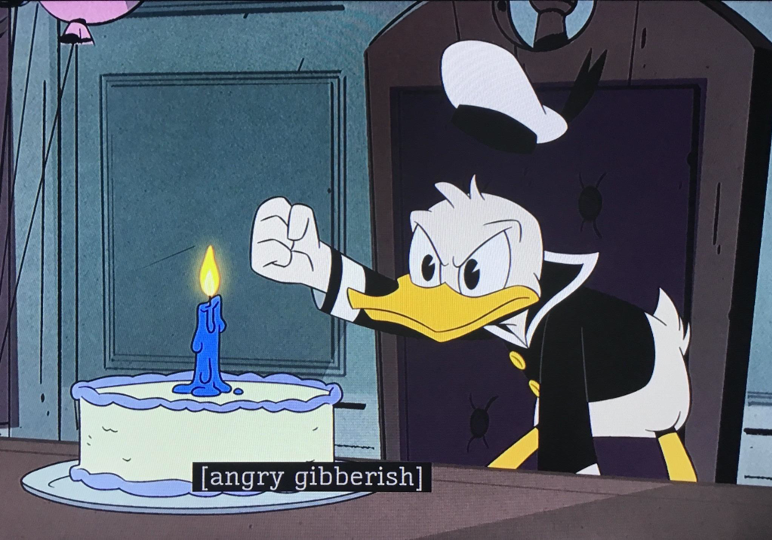Throughout human history, the labor of civil rights has been done by the oppressed. In disability advocacy especially, disability representation and media have been amplified, and critiqued, by the Disability Visibility Project. It is also the assertion of this community that civil rights and advancement can only be made when the oppressed are involved. Representation is especially key, as traditionally the language of the oppressed has been policed by the oppressors, who disregard the authority of lived experience by arbitrary, and impossible, metrics of reason, logic, and calmness. However, the oppressed have claim to rage, and the systemic violence that inspires and represses that rage can be understood through mass media texts across decades.

A case study in rage is Donald Duck. Donald, in addition to being a top-billed Disney star, is a Navy Veteran, a world-class adventurer, and a loving uncle. Donald has been starring in Disney comics, shorts, and features since 1934. He is second in recognition only to Mickey Mouse, who needs no introduction. At Mickey’s inception, he was a wily, deviant, trickster character, prone to pulling pranks and flying into fits of rage. In one of their earliest shorts together, The Band Concert (1937), Donald played the good-natured goof, inspiring a local band to play “Turkey in the Straw,” while Mickey responded by shouting, threats, and breaking the duck’s numerous flutes.
But when Mickey gained popularity and more commercial opportunity, he was reimagined as a clean-living leading-man, and Donald was introduced as the madcap site of outrage and outrageousness. Shrill and short-tempered, his function has only ever been to be the comedic foil to the newly normalized Mickey (see Klein 1998). Their comedic rolls are most notably reversed in Magician Mickey (1937). Donald is still a disruptive audience member but is now a mean spirited heckler rather than an enthusiastic flutist. Mickey mocks him and incorporates the duck into his tricks, but seems unfazed by Donald’s insults. They are like water off a duck’s back.
Donald is coded as a white, middle class, cisgender male, and understood to be an “everyman” character. While Donald was not designed to stand in for the oppressed, we can understand a great deal of our cultural reaction to his rage. Donald’s struggle is intersectional despite the sanitization of his political identity. He is marked as “other” by his first, and best, mechanism to be understood: his voice. Donald’s world is not absurdist, and his rage at everyday trials denotes that these trials are more difficult for him through the extra labor of trying to be understood. His voice is also unique among the Disney Ducks. For example, Daisy, Scrooge, and his nephews have no difficulty speaking or understanding each other.

Donald has regained his voice twice. The first time was in Donald’s Dream Voice (1948). The short features Donald as a door-to-door brush salesman who can’t make a sale. His would-be clients can’t understand him and slam their doors in his face. His sweetheart Daisy listens to him patiently and offers support. Donald happens upon another salesman selling voice pills. He buys them, takes them, and finds he can now speak in a sweet tenor. The fowl is not foul: he doesn’t desire revenge on the people who violently dismissed him. He wishes to earn enough money to propose to Daisy and lead an unmarked and unremarkable life.
It is not long before, through a string of increasingly bad luck, Donald loses his voice pills and any relief from his burden of being misunderstood. The voice was not his dream, it was the mechanism by which he could reasonably realize his dream. His response is rage, but with the context of his hopes we can understand his rage better.
The impetus of writing and producing this particular short was likely less about engaging the population with new socio-structural cognitive tools to elevate all citizens, and more about finding a new way to abuse Donald, the longest suffering of all ducks.
Donald regains his voice again, nearly 70 years later, in the season one finale of DuckTales. As the town of Duckburg is threatened by an army of magic shadows, he tries to give battle instructions to his family, who complain that they really only understand what he is saying through context, and are only certain of about every third word. The family’s mad scientist, sick of trying to understand Donald, violently shoves a technological voice box down his throat. As Donald’s voice changes, so does his esteem with his family. He takes charge, leads his nephews into battle, and begins turning out memetic catchphrases such as “Ducks don’t back down!” Their revolution is a success, and as the shadows retreat, the voice box short-circuits and Donald coughs it up.

Since the 1948 short, Donald has gained more accolades but lost his autonomy. This is an exceptionally dense episode, and Donald’s new voice is an ancillary comedic plot that holds no space for his character development or even his reaction to losing the voice box. The comedy is in the incongruous concept that the previously ridiculous duck has always been an inspiring leader. When he is normalized, his rage is resplendent. When he is Othered, his rage is a joke.
On a global scale, both historically and immediately, we have to contextualize and contend with rage as a political tool. While Donald’s rage has always been played for laughs, he as a character should not be easily dismissed, by either his writers or audience. Our media culture informs how we respond to the anger of those raging to be understood. That we recognize ourselves and each other in his everyday frustrations makes Donald one lucky duck.
References
Klein, Norman M. (1998), Seven Minutes: The Life and Death of the American Animated Cartoon. London: Verso.
Devlin Grimm is a Los Angeles based media scholar and art educator. Devlin has a Masters in Aesthetics and Politics and has been described as an odd duck.
